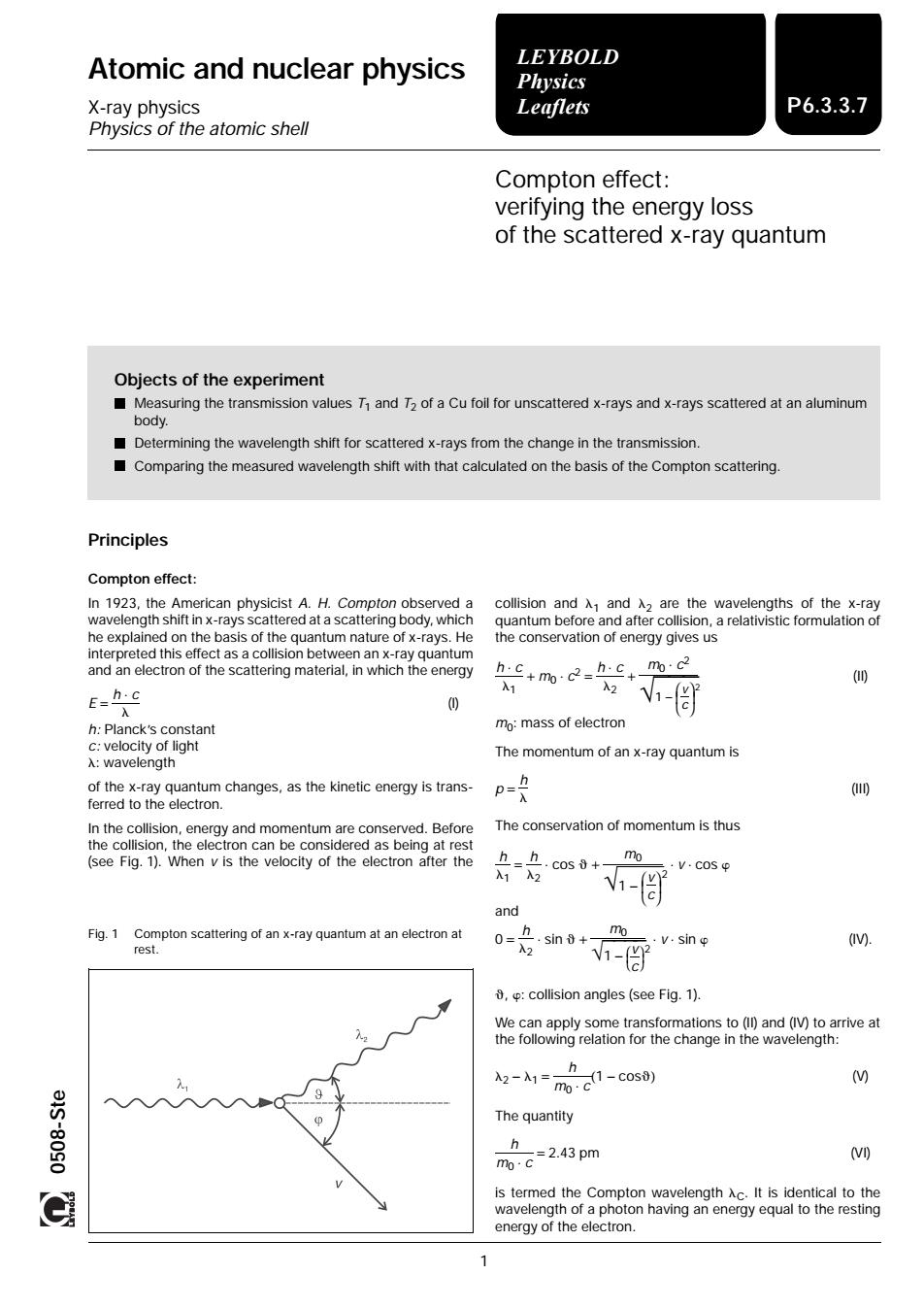正在加载图片...

Atomic and nuclear physics LEYBOLD Physics X-ray physics Leaflets P6.3.3.7 Physics of the atomic shell Compton effect: verifying the energy loss of the scattered x-ray quantum Objects of the experiment Measuring the transmission values and T2 of a Cu foil for unscattered x-rays and x-rays scattered at an aluminum body. Determining the wavelength shift for scattered x-rays from the change in the transmission. ■ I Comparing the measured wavelength shift with that calculated on the basis of the Compton scattering. Principles Compton effect: In 1923,the American physicist A.H.Compton observed a collision and1 and A2 are the wavelengths of the x-ray wavelength shift in x-rays scattered at a scattering body,which quantum before and after collision,a relativistic formulation of he explained on the basis of the quantum nature of x-rays.He the conservation of energy gives us interpreted this effect as a collision between an x-ray quantum and an electron of the scattering material,in which the energy h.c +mo.c2=h.c m0·c2 E=h.c A1 2 0 V1- h:Planck's constant mo:mass of electron c:velocity of light The momentum of an x-ray quantum is λ:wavelength of the x-ray quantum changes,as the kinetic energy is trans- h p= (0 ferred to the electron. In the collision,energy and momentum are conserved.Before The conservation of momentum is thus the collision,the electron can be considered as being at rest (see Fig.1).When v is the velocity of the electron after the hh mo 入1 入2 and Fig.1 Compton scattering of an x-ray quantum at an electron at mo 0= sin λ2 y.sin (. rest 1- collision angles (see Fig.1). We can apply some transformations to (l)and (IV)to arrive at the following relation for the change in the wavelength: A2-入1 mo·c1-cos8) h (M The quantity moc=2.43 pm h (VI) C is termed the Compton wavelength Ac.It is identical to the wavelength of a photon having an energy equal to the resting energy of the electron.Fig. 1 Compton scattering of an x-ray quantum at an electron at rest. Atomic and nuclear physics X-ray physics Physics of the atomic shell LEYBOLD Physics Leaflets Compton effect: verifying the energy loss of the scattered x-ray quantum Objects of the experiment Measuring the transmission values T1 and T2 of a Cu foil for unscattered x-rays and x-rays scattered at an aluminum body. Determining the wavelength shift for scattered x-rays from the change in the transmission. Comparing the measured wavelength shift with that calculated on the basis of the Compton scattering. Principles Compton effect: In 1923, the American physicist A. H. Compton observed a wavelength shift in x-rays scattered at a scattering body, which he explained on the basis of the quantum nature of x-rays. He interpreted this effect as a collision between an x-ray quantum and an electron of the scattering material, in which the energy E = h ⋅ c l (I) h: Planck’s constant c: velocity of light l: wavelength of the x-ray quantum changes, as the kinetic energy is transferred to the electron. In the collision, energy and momentum are conserved. Before the collision, the electron can be considered as being at rest (see Fig. 1). When v is the velocity of the electron after the collision and l1 and l2 are the wavelengths of the x-ray quantum before and after collision, a relativistic formulation of the conservation of energy gives us h ⋅ c l1 + m0 ⋅ c2 = h ⋅ c l2 + m0 ⋅ c2 √1 − v c 2 (II) m0: mass of electron The momentum of an x-ray quantum is p = h l (III) The conservation of momentum is thus h l1 = h l2 ⋅ cos q + m0 √1 − v c 2 ⋅ v ⋅ cos w and 0 = h l2 ⋅ sin q + m0 √ 1 − v c 2 ⋅ v ⋅ sin w (IV). q, w: collision angles (see Fig. 1). We can apply some transformations to (II) and (IV) to arrive at the following relation for the change in the wavelength: l2 − l1 = h m0 ⋅ c (1 − cosq) (V) The quantity h m0 ⋅ c = 2.43 pm (VI) is termed the Compton wavelength lC. It is identical to the wavelength of a photon having an energy equal to the resting energy of the electron. P6.3.3.7 0508-Ste 1